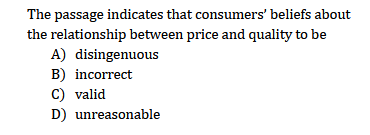How to Outsmart Reading Questions


One of the most common ACT and SAT strategies I review with students is how to use the answer choices to their advantage. Multiple choice exams actively invite this as a strategy: at worst, students have a 20-25 percent chance of guessing correctly at random, and that number can more than double when students learn to effectively apply strategies such as back-solving or process of elimination! Therefore, students are often shocked when I tell them not to look at the answer choices on the Reading sections of the exams.
To be more specific, my advice is that students should not look at the answer choices until after they have tried answering the question in their own words.
Cognitive studies have shown that students approach multiple choice questions differently than open response questions. When presented with a short response question, students are forced to focus on recall and ask themselves questions such as “What is the question asking?” and “What do I know about the topic?”. When those same students are confronted with a multiple choice question, they instead focus on recognition,looking for familiar information in each answer choice to make the answer fit the question. Since test-makers for the ACT and SAT know that this is how students approach these questions, they often structure answer choices in ways that make them easily recognizable and open to interpretation; this is why students often find themselves stuck between answer choices.
Example:


By working through the answer choices, choices A and C can be quickly eliminated; disingenuous would mean the consumer is being insincere, which is not supported by the text, and choice C contradicts the latter portion of text which states that price is only loosely correlated to quality. However, choices B and D are very similar; a student could very easily attempt to justify either. This strategy can often cost students valuable time as they re-read and compare the answer choices many times over, often ending with an educated, although still uncertain guess. Instead, students might try viewing the question as if it were open ended, without the influence of predetermined answer choices. I’ve tested this strategy with students both in classes and private sessions by presenting this exact example without the answer choices and asking, “what does the passage tell you about consumers’ beliefs on price and quality?”, and most students answer with a statement along the lines of, “The consumers are wrong”. This makes the answer substantially clearer; the word “incorrect” in choice B is a direct synonym for the students’ answer and is correct; the word "unreasonable" would add additional meaning not directly supported by the passage.
This is not to say that students should never use the answer choices. Process of elimination can be an excellent tool when used correctly, and answer choices often provide context clues that can help students identify what a question is asking for or where to find relevant information in the passage. However, these strategies can also be time consuming and prevent students from focusing on the question’s main idea. By answering in their own words first, students have the opportunity to approach questions efficiently and with the confidence won’t be tricked by the wording of the answer choices.
